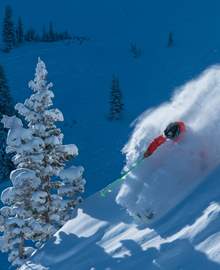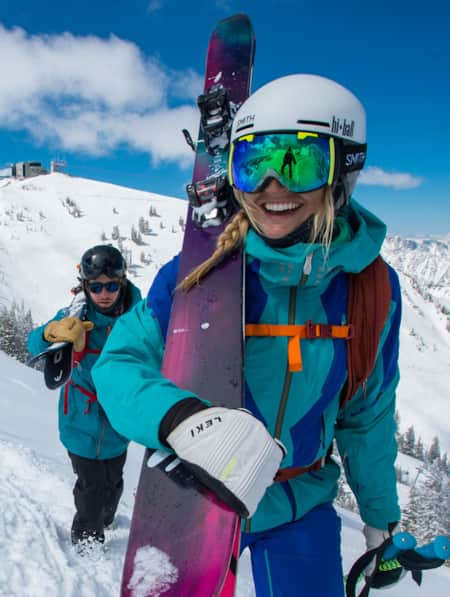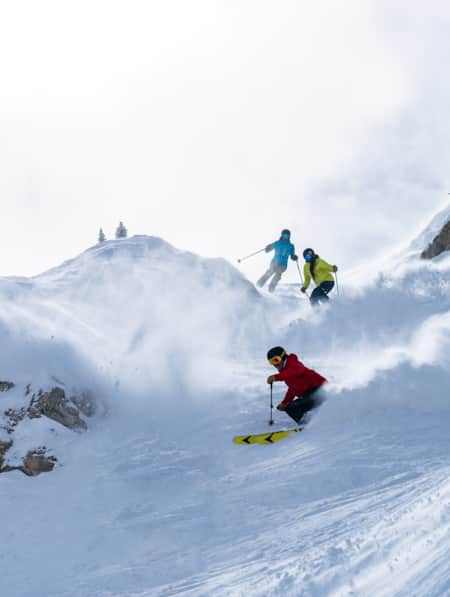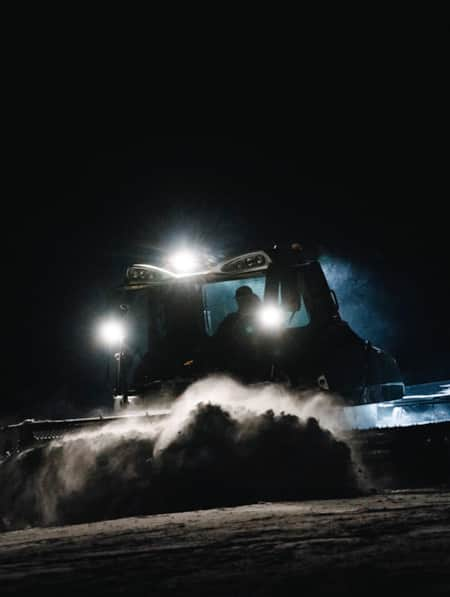7 Skiing Tips for More Fun on the Mountain

Skiing is one of the most fun and exciting sports on earth, but a good ski trip isn’t guaranteed when you book the trip. Gear, a good attitude and lessons can help ensure that you have a fun time. We’ve enlisted some advice from Andy Baker, a 24-year full-time ski instructor at Alta Ski Area's Alf Engen Ski School and PSIA Level III Certified Instructor to offer a few tips to make your time on the mountain as enjoyable as possible.
Visiting from lower elevations? Get familiar with our tips for staying healthy as you ascend.
1. Bundle Up
Whether you are new to the slopes or a seasoned veteran, wearing the right clothing can make or break your comfort level while on the mountain. Your base layer is what you build upon and should help wick sweat off your skin and keep you warm. Avoid cotton and go for wool or synthetic materials. For your mid layer choose a fleece or wool top. “I tell people to buy shell pants and a shell jacket, so you can layer underneath, depending on the conditions,” says Baker. If you go the other route and get an insulated jacket, get one that has good armpit zips for ventilation and a waterproof rating of 10,000 mm or higher. (Read: How to Pack for a Family Snow and Ski Trip in Utah)
2. Get The Right Gear
Generally speaking, when standing straight up your ski length should come somewhere between your chin and the top of your head. Beginner skiers will want to choose shorter skis, while longer skis are more appropriate for advanced skiers. To ensure that you get the right size ski length visit a ski shop and they will help advise you on length based on your skill level. Ski bindings are designed to release the skis in the event of a crash and the binding settings are based on your height, weight, age and ability. As for poles and the proper length, stand in your ski boots and hold your poles — your elbows should be at a 90-degree angle.
Two of the most important things are eye protection and a proper helmet with a hard outer shell and a foam inner liner. Eye protection is essential to protect your eyes from the elements of weather and harmful UV rays. Goggles offer more protection and give you a wider field of vision than sunglasses. Whether you’re a beginner or an expert, everyone should wear a helmet. Not only do they protect your head in case of a fall or from sharp objects, but they help keep you warm all day. (Read: Ski Rental and Retail Options)
3. Take a Lesson
Although first-timers are highly encouraged to take lessons, ski school isn’t just for beginners. Lessons can help improve technique or address fears. “I like to instill more education and knowledge in where they are on their ski abilities and ensure that they have the basic foundation that will ultimately help them accomplish their goals. Ultimately, time on the snow helps your muscle memory, so when you are ready to move up, you’re really ready and your body can react appropriately, “ says Baker. See these articles about beginner’s ski school and/or adult ski lessons for more advanced skiers at some of Utah’s resorts.
4. Ski At Your Level
Ski levels are typically broken into three categories: beginner, intermediate and advanced. If you are brand new to skiing, stick to the bunny hill or green runs only. As you gain more confidence and skill you also develop more control and speed to tackle more difficult terrain. Get familiar with the mountain you are visiting by checking out the map and seeing where different rated runs are located. See a quick guide to five of Utah’s best beginner ski runs and snowboard trails.

Remember that ski school isn’t just for beginners. Lessons can help improve technique or address fears.

Wearing the right clothing can make or break your comfort level while on the mountain.

Get familiar with the mountain you are visiting by checking out the map and seeing where different rated runs are located.
5. Communication
Communication might seem like a no brainer but it is often overlooked, sometimes leading to assumptions being made about how people are feeling. Communicating with your ski partners about the weather, where you want to ski, comfort levels, or when it’s time to take a break all contribute to everyone having a good time. Good communication is just as important when taking ski lessons. As Baker advises, students’ words don’t always match their physical reactions. If you’re concerned about something, let your instructor or group know.
6. Patience & Practice
The saying practice makes perfect applies to skiing and boarding but lots of practice requires patience too. People who are already good at a handful of sports sometimes have expectations about how long it will take them to move up in skill level. Some days may be easier than others on the mountain so it’s important to adjust your expectations for each day that you are out. Having a good attitude and staying positive even if you take a little tumble will add to your overall experience. And if you find yourself in a crowded lodge, lift line or ski run, remember that anytime you are in a crowd, you are the crowd. Have patience and be considerate of those you are sharing this outdoor space with.
7. Know the Code
Wherever you ski, the snow safety code includes the same basic principles seen below. Knowing them will keep you and others safe on the slopes.
- Always stay in control, and be able to stop or avoid other people or objects.
- People ahead of you have the right of way. It is your responsibility to avoid them.
- You must not stop where you obstruct a trail, or are not visible from above.
- Whenever starting downhill or merging into a trail, look uphill and yield to others.
- Always use straps and devices to help prevent runaway equipment.
- Observe all posted signs and warnings. Keep off closed trails and out of closed areas.
- Prior to using any lift, you must have the knowledge and ability to load, ride and unload safely.
Bonus Tip
For more expert tips for planning your Utah ski trip, check out this article by local forecaster Evan Thayer.
The Basics
-
Ski & Snowboard FAQs
Are you planning your cold-weather vacation to Utah? Find winter travel tips on highway safety, liquor law information, skiing and snowboarding gear.
-
Utah Snow Report
Is it snowing? We certainly hope so. Check snow reports, weather forecasts, road conditions and live webcams for all of Utah’s 15 world-class ski resorts.
-
Where to Stay
Explore ski-in/ski-out lodges and downtown hotels. With so many places to stay for a Utah ski trip, it’s easy to find affordable or luxury options.
-
Winter Activities
Winters in Utah may be known for having The Greatest Snow on Earth®, but there is so much more to explore off the slopes.



























